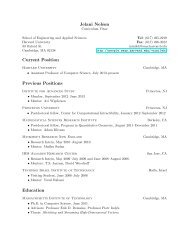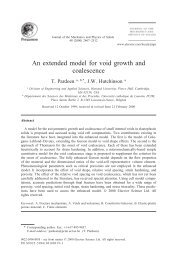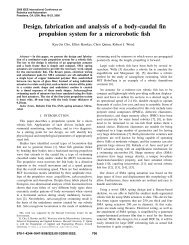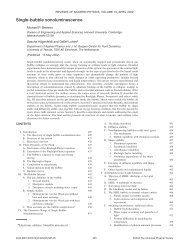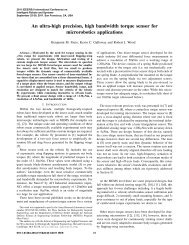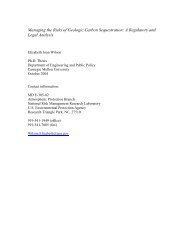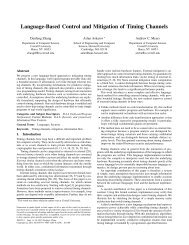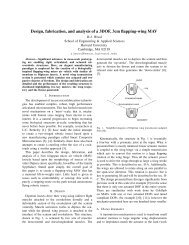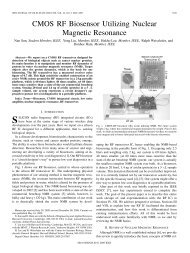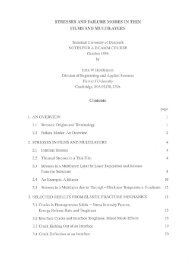Biological glass fibers: Correlation between optical and structural ...
Biological glass fibers: Correlation between optical and structural ...
Biological glass fibers: Correlation between optical and structural ...
You also want an ePaper? Increase the reach of your titles
YUMPU automatically turns print PDFs into web optimized ePapers that Google loves.
Fig. 2. Structural <strong>and</strong> compositional characterization of the basalia spicules. (a)SEM image of a mechanically cleaved freest<strong>and</strong>ing spicule, revealing an axialorganic filament (OF), a smooth central cylinder (CC), <strong>and</strong> a striated shell region(SS). (Inset) SEM image of a similar spicule that was gently polished after embeddingin an epoxide. A smooth homogeneous cross section is now seen. (b) Etchfigures produced after HF treatment. The exposed CC region with the hollow core(indicated by an arrow) <strong>and</strong> surrounded by a receding series of SS layers is seen.(Inset) High-magnification scanning electron micrograph of the etched coreregion (2 m in diameter), exposing the OF. (c) Etch figures produced afterbleach (NaOCl) treatment reveal that the spicule’s building blocks are silicaspheres. Arrows indicate the interfaces <strong>between</strong> the shell layers, from whichorganic material is selectively removed. (Inset) Magnified view of the interface,revealing remnants of the organic bridges. (d Left) EDX carbon map of Microtome-cutspicule cross section highlights the presence of an OF. Note that thecarbon content in the CC region is higher than that in the SS region. (Right) EDXsodium map indicates an enhanced concentration of sodium ions within thespicule cross section, with the highest density of Na occurring in the 2-m core.(Insets) SEM images of the corresponding spicules.Although the absolute values of the refractive index vary alongthe length of the fiber, the same pattern is evident in all regions.First, there is a high refractive index core (1–2 m in diameter)that corresponds to the Na-doped region in EDX, in which thespicule’s refractive index (1.45–1.48) is very close to (or higher!than) that of vitreous silica of 1.458 (Fig. 3b). Second, surroundingthis core is a larger cylindrical tube (15–25 m in diameter),which has a lower refractive index (as low as 1.425) than theNa-doped core. This cylinder corresponds well to the CC regiondetected in the <strong>structural</strong> studies, <strong>and</strong> its reduced refractiveindex could be explained by its high organic content <strong>and</strong>or lowdegree of silica condensation. Last, the outer portion of thespicule shows a progressively increasing refractive index (from1.433 to 1.438), in agreement with the observed gradual compositionvariation (Fig. 2b) <strong>and</strong> the increasing diameter of thesilica spheres in the SS layers. An oscillatory pattern of therefractive index in this region is consistent with the presence ofwell defined b<strong>and</strong>s of organic molecules, seen as bridging lig<strong>and</strong>sat the interfaces <strong>between</strong> the layers (see Fig. 2c). The finite<strong>optical</strong> resolution of the refractive index measurement (on theorder of 1 m) limits the accurate spatial resolution of theoscillatory pattern.Varnham et al. (15) showed how the difference <strong>between</strong>refractive index measurements acquired with axial <strong>and</strong> transversepolarizations (i.e., the birefringence) could be used tomeasure residual thermal stresses in commercial <strong>optical</strong> fiberpreforms or <strong>fibers</strong>. Polarization-specific refractive index measurementsof the spicules are summarized in Fig. 3c. Althoughthe absolute refractive index in the core region for eitherpolarization was substantially higher than that of vitreous silica(as high as 1.48), along the cross section of the spicule therefractive index profiles for the different polarizations of lightwere largely identical. Even in the core, the observed differencein refractive index of 0.002 was at the detection threshold of theinterferometric index profiler.The revealed characteristic ‘‘core-cladding’’ structure of thespicules raised the interesting possibility that these biologicallyformed <strong>fibers</strong> may possess waveguiding properties, <strong>and</strong> theircore could carry a single-mode <strong>optical</strong> signal (6). Variouslight-coupling experiments were performed to address this question(Fig. 4). Indeed, experiments with spicule sections embeddedin epoxide <strong>and</strong> coupled to white light indicate that light istransported predominantly through the core of the spicule <strong>and</strong>a narrow region surrounding the core <strong>and</strong> that not much light istransported through the cladding layer (i.e., either the striatedshell region or the central cylinder) (Fig. 4b), as would beexpected in a singlefew-mode <strong>optical</strong> fiber. Such waveguidingcharacteristics of these spicules result from the raised refractiveindex of the epoxide (1.57) relative to that of the cladding.In natural environments, however, the spicules are surroundedby seawater. The refractive index difference (n m ) <strong>between</strong> thespicule’s biosilica (1.43) <strong>and</strong> the surroundings (1.33) is,therefore, much larger than the refractive index difference (n s )<strong>between</strong> the core <strong>and</strong> the cladding (Fig. 3d). Moreover, thecladding diameter is much larger than the core diameter. Thesefacts suggest that in natural environments, it is far more likelythat the light would be strongly confined within the entirespicule, which should then function as a multimode fiber. Tobetter approximate biological conditions, red laser light wasfree-space coupled from an <strong>optical</strong> fiber into the spicule in air(Fig. 4a). Light guided through the spicule was clearly visible <strong>and</strong>imaged onto a screen through an objective (Fig. 4a Inset). Whenwhite light was coupled into the spicule through this optimizedsetup, the spicule behaved as a highly multimode light guide; thatis, most of the light traveling inside the fiber filled the entirecladding <strong>and</strong> was confined by the outer surface of the fiber (Fig.4c), because of the enhanced refractive index contrast <strong>between</strong>the spicule <strong>and</strong> the surroundings (air).3360 www.pnas.orgcgidoi10.1073pnas.0307843101 Aizenberg et al.
Fig. 4. Light-coupling experiments. (a) Free-space coupling of light to a free fractured spicule results in the entire fiber being illuminated. Right <strong>and</strong> Left areimages of the experimental setup in the presence <strong>and</strong> absence of room light. Referenced with arrows (a <strong>and</strong> b) are the input <strong>and</strong> output ends of the spicule.(Inset) Output of the spicule imaged on a screen. (b) Transmission <strong>optical</strong> image of a spicule embedded in epoxide. The 2-m core region is brighter than thecladding, showing that the fiber acts as a single-mode (few-mode) waveguide. (c) Transmission image of a freest<strong>and</strong>ing spicule. Entire fiber is lit up, showingthat the fiber acts as a highly multimode waveguide. (d) Light coupling into the spined regions of the fiber. (Upper) Optical micrograph of the original fiber withthe spine positions labeled with arrows. (Lower) Optical image of the same fiber upon free-space coupling of white light into the fiber. Although the bulk ofthe fiber is substantially dark, select illumination points corresponding to the spine positions are observed. (Inset) Interferometric image showing the extensionof the striated shell into the spined region of the spicule.<strong>optical</strong> network with selected illumination points along thelength of the crown-like fibrous network surrounding the cylindricalskeletal lattice.Second, the formation of the biosilica <strong>fibers</strong> occurs at ambienttemperatures <strong>and</strong> pressures. Their complex structure <strong>and</strong> compositionare encoded in the organism <strong>and</strong> are controlled byspecialized organic molecules <strong>and</strong> cells. The low-temperatureformation of silica in organisms, as an alternative to the hightemperaturetechnological process (24), is a subject of extensivestudies (25–32). It has been shown that proteinaceous axialfilaments isolated from the Eastern Pacific demosponge Tethyaaurantia <strong>and</strong> their constituent proteins, silicateins (extractedfrom the filaments or produced from recombinant DNA templates)were effective in the in vitro induction of hydrolysis <strong>and</strong>polycondensation of silicon alkoxides to yield silica at ambienttemperature <strong>and</strong> pressure <strong>and</strong> neutral pH (25, 26, 30–32).Previous work investigating the mechanisms of silicification indiatoms suggested that the formation of silica nanoparticles isdirected by specific polycationic peptides, silaffins (27–29).The low-temperature synthesis brings about an extremelyimportant feature: the ability to effectively dope the structurewith impurities that increase the refractive index of silica. Ourelemental analysis showed, for example, the presence of sodiumions in the entire fiber, particularly in the core. Sodium ions (<strong>and</strong>many other additives) are not commercially viable <strong>optical</strong> fiberdopants because of manufacturing challenges, including devitrificationat high processing temperatures. In the case of thesespicules, however, the presence of sodium ions results in theincrease of the refractive index to values approaching <strong>and</strong> evenexceeding that of vitreous silica.The transmission loss of commercial <strong>fibers</strong> is primarily limitedby Rayleigh scattering due to small density fluctuations inevitablydistributed in the vitreous silica, therefore a fiber composedof a collection of vitreous silica nanospheres would likelyexhibit much higher amounts of Rayleigh scattering <strong>and</strong> beimpractical for long-distance low-loss signal transmission applications.However, other specialty commercial <strong>fibers</strong>, such asrare-earth-doped <strong>fibers</strong>, are used to amplify <strong>optical</strong> signals overshort lengths of fiber (10 m), so nanospheres might not be asignificant disadvantage <strong>and</strong> room temperature fabricationmight permit the inclusion of novel useful dopant species.Another advantage of the low-temperature synthesis is evidencedin the lack of the polarization dependence on therefractive index. Birefringence in commercially prepared <strong>fibers</strong>often occurs as a result of the residual thermal stresses in the<strong>fibers</strong> upon their cooling (15). Ambient condition formation ofthe spicules in biological environments prevents the developmentof any residual thermal stress.We wonder whether the observed remarkable fiber-<strong>optical</strong>capabilities of these spicules are actually used by this species inthe wild or are accidental, a fascinating question worthy offurther investigation. We can only speculate at this moment thatthese silica spicules, beyond <strong>structural</strong> anchorage support, mayalso provide an intricate network of naturally formed <strong>optical</strong><strong>fibers</strong>. While fibrous spicules in the shallower-dwelling Rosellaracovitzae have been postulated to act as an effective lightcollectingsystem, delivering sunlight to the sponge’s presumablyendosymbiotic algae (4, 5, 7), we do not yet know whether asimilar relationship might exist in Euplectella. Indeed, in thepresence of sufficient light, a variety of <strong>optical</strong> elements, rangingfrom iridescent gratings to efficient microlens arrays, have beendeveloped by nature (18, 33, 34). The hexactenellid sponge E.aspergillum, however, typically occurs at depths at which thepaucity of ambient sunlight, high pressure, <strong>and</strong> hydrothermal3362 www.pnas.orgcgidoi10.1073pnas.0307843101 Aizenberg et al.
vents lead to bio- or chemiluminescence being the only feasiblesources of illumination (35–37).Our results suggest that if such sources exist within or in closeassociation to the basalia of E. aspergillum, their light might beefficiently used <strong>and</strong> distributed by the sponge. Such a fiber<strong>optical</strong>lamp might potentially act as an attractant for larval orjuvenile stages of these organisms <strong>and</strong> symbiotic shrimp to thehost sponge. Whether <strong>and</strong> how the latter are adapted forphotoreception presents another unexplored question (18, 36).Further analysis might also examine the possible presence ofbioluminescent microorganisms (35–37) that live symbiotically atdepths typically inhabited by this organism <strong>and</strong> explore thepotentially mutualistic benefits for both species involved in theseapparent symbioses.We can also, at this point, not rule out the possibility that theobserved fiber-optic properties of these spicules may in fact notbe biologically relevant <strong>and</strong> may merely be a secondary consequenceof the evolution of a flexible fracture-resistant skeletalsystem successful for the colonization on soft substrates (11).In conclusion, we have demonstrated an example of nature’sability to evolve highly effective <strong>and</strong> sophisticated <strong>optical</strong> systems,comparable <strong>and</strong> in some aspects superior to man-madeanalogs. High fracture toughness arising from their compositestructure, the presence of index-raising dopants, the degree ofsilica condensation, <strong>and</strong> the absence of residual stress in these<strong>fibers</strong> suggest an advantage of the protein-controlled, ambienttemperaturesynthesis favored in nature. Whether these <strong>optical</strong>properties are biologically relevant or not, the mechanisms of theformation of silica spicules in E. aspergillum are inspiring tomaterials scientists <strong>and</strong> engineers. We believe, therefore, thatthis system represents a new route to improved, silica-based<strong>optical</strong> <strong>fibers</strong>, constructed by using a bottom-up approach.We thank D. E. Morse, M. Yan, W. White, <strong>and</strong> O. Mitrofanov forconstructive discussions <strong>and</strong> A. D. Grazul for the sample preparation forelemental analysis. J.C.W. was supported by grants from the U.S.Department of Energy (DE-FG03-02ER46006), the National Aeronautics<strong>and</strong> Space Administration (NAG1-01-003 <strong>and</strong> NCC-1-02037), <strong>and</strong>the Institute for Collaborative Biotechnologies through Grant DAAD19-03-D-0004 from the U.S. Army Research Office.1. Reiswig, H. M. & Mackie, G. O. (1983) Philos. Trans. R. Soc. London B 301,419–428.2. Koehl, M. A. R. (1982) J. Exp. Biol. 98, 239–244.3. Simpson, T. L. (1984) The Cell Biology of Sponges (Springer, New York.4. Cattaneo-Vietti, R., Bavestrello, G., Cerrano, C., Sara, M., Benatti, U.,Giovine, M. & Gaino, E. (1996) Nature 383, 397–398.5. Sarikaya, M., Fong, H., Sunderl<strong>and</strong>, N., Flinn, B. D., Mayer, G., Mescher, A.& Gaino, E. (2001) J. Mater. Res. 16, 1420–1428.6. Sundar, V. C., Yablon, A. D., Grazul, J. L., Ilan, M. & Aizenberg, J. (2003)Nature 424, 899–900.7. Gaino, G. & Sarà, M. (1994) Marine Ecol. Prog. Ser. 108, 147–151.8. Perry, C. C. & Keeling-Tucker, T. (2000) J. Biol. Inorg. Chem. 5, 537–550.9. Beaulieu, S. E. (2001) Marine Biol. 138, 803–817.10. Saito, T. & Takeda, M. (2003) J. Marine Biol. Assoc. U.K. 83, 119–131.11. Lévi, C., Barton, J. L., Guillemet, C., Le Bras, E. & Lehuede, P. (1989) J. Mater.Sci. Lett. 8, 337–339.12. Schwab, D. W. & Shore, R. E. (1971) Nature 232, 501–504.13. Weaver, J. C., Pietrasanta, L. I., Hedin, N., Chmelka, N., Hansma, P. K. &Morse, D. E. (2003) J. Struct. Biol. 144, 271–281.14. Marcuse D. (1981) Principles of Optical Fiber Measurements (Academic, New York).15. Varnham, M. P., Poole, S. B. & Payne, D. N. (1984) Electron. Lett. 20,1034–1035.16. Aizenberg, J., Weiner, S. & Addadi, L. (2003) Connect. Tissue Res. 44, 20–25.17. Beadle, W. E., Tsai, J. C. C. & Plummer. R. D. (1985) Quick Reference ManualFor Silicon Integrated Circuit Technology (Wiley, New York).18. Aizenberg, J., Tkachenko, A., Weiner, S., Addadi, L. & Hendler, G. (2001)Nature 412, 819–822.19. Ghatak, A. & Thyagarajan, K. (1998) Introduction to Fiber Optics (CambridgeUniv. Press, New York).20. Clegg, W. J., Kendall, K., Alford, N. M., Button, T. W. & Birchall, J. D. (1990)Nature 347, 455–457.21. Mayer, G. & Sarikaya, M. (2002) Exp. Mech. 42, 395–403.22. Kamat, S., Su, X., Ballarini, R. & Heuer, A. H. (2000) Nature 405, 1036–1040.23. Smith, B. L., Schaffer, T. E., Viani, M., Thompson, J. B., Frederick, N. A.,Kindt, J., Belcher, A., Stucky, G. D., Morse, D. E. & Hansma, P. K. (1999)Nature 399, 761–763.24. Morse, D. E. (1999) Trends Biotechnol. 17, 230–232.25. Shimizu, K., Cha, J., Stucky, G. D. & Morse, D. E. (1998) Proc. Natl. Acad. Sci.USA 95, 6234–6238.26. Cha, J. N., Shimizu, K., Zhou, Y., Christiansen, S. C., Chmelka, B. F., Stucky,G. D. & Morse, D. E. (1999) Proc. Natl. Acad. Sci. USA 96, 361–365.27. Kroger, N., Deutzmann, R., Bergsdorf, C. & Sumper, M. (2000) Proc. Natl.Acad. Sci. USA 97, 14133–14138.28. Kroger, N., Deutzmann, R. & Sumper, M. (1999) Science 286, 1129–1132.29. Kroger, N., Lorenz, S., Brunner, E. & Sumper, M. (2002) Science 298, 584–586.30. Cha, J. N., Stucky, G. D., Morse, D. E. & Deming, T. J. (2000) Nature 403,289–292.31. Weaver, J. C. & Morse, D. E. (2003) Microsc. Res. Tech. 62, 356–367.32. Zhou, Y., Shimizu, K., Cha, J. N., Stucky, G. D. & Morse, D. E. (1999) Angew.Chem. Intl. Ed. 38, 779–782.33. Parker, A. R., McPhedran, R. C., McKenzie, D. R., Botten, L. C. & Nicorovici,N.-A. P. (2001) Nature 409, 36–37.34. Vukusic, P. & Sambles, J. R. (2003) Nature 424, 852–855.35. Wilson, T. & Hastings, J. W. (1998) Annu. Rev. Cell Dev. Biol. 14, 197–230.36. Chamberlain, S. C. (2000) Philos. Trans. R. Soc. London B 355, 1151–1154.37. White, S. N., Chave, A. D., Reynolds, G. T., Gaidos, E. J., Tyson, J. A. & VanDover, C. L. (2000) Geophys. Res. Lett. 27, 1151–1154.PHYSICSAizenberg et al. PNAS March 9, 2004 vol. 101 no. 10 3363



